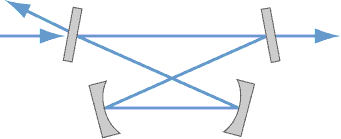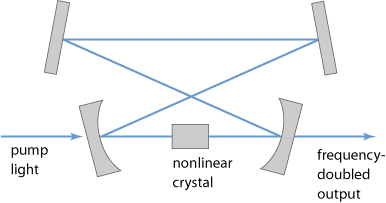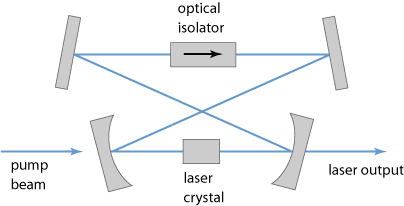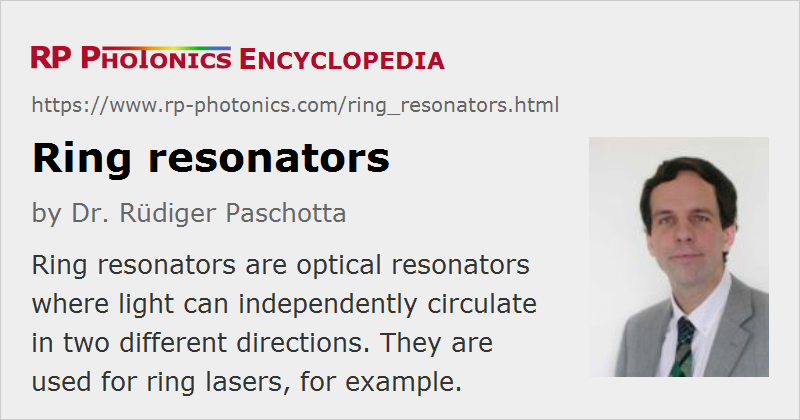Ring Resonators
Definition: optical resonators where light can independently circulate in two different directions
More general term: optical resonators
Opposite term: linear resonators, standing-wave resonators
German: Ringresonatoren
How to cite the article; suggest additional literature
Author: Dr. Rüdiger Paschotta
Optical resonators can be made with two different topologies:
- Linear resonators (standing-wave resonators) have two end mirrors with perpendicular incidence of light. Circulating light will then inevitably have two counterpropagating components.
- Ring resonators do not have any end mirrors; none of the resonator mirrors reflects light back into itself.
As an example, Figure 1 shows a ring resonator, where light is injected through a partially transmissive mirror, and light is coupled out through another mirror:

Note that the incident light leads to light circulating in the resonator only in one direction. Therefore, one obtains a single output beam on the upper right side.
If the transmission of both plane mirrors is the same and the two curved mirrors are highly reflecting, we have impedance matching in resonance: all incident power is transmitted on the other side, and there is effectively no reflected power, because the directly reflected component and the light leaking out from the resonator cancel each other by destructive interference.
Different Forms of Ring Resonators
Ring resonators may be formed by combining some laser mirrors as shown above. However, there are other possibilities:

- One may employ total internal reflection. This is done for nonplanar ring oscillators, for example (see Figure 2). Ref. [4] provides another example, where evanescent wave coupling with a prism is used. That mechanism provides a variable degree of coupling.
- One can use fiber optics to form a fiber ring resonator. That way, one can realize resonators with a very long round-trip time. A fiber coupler can be used for coupling the light into the resonator or for extracting it.
- A spherical glass piece can be used as a ring resonator, exhibiting so-called whispering gallery modes. Coupling is possible with a prism, using evanescent waves.
- There are micro-ring cavities which are realized with integrated optics as waveguide structures. Here, one may employ evanescent wave coupling with a straight waveguide passing the ring in a close distance.
Differences to Linear Resonators
In various respects, the properties of the ring resonators differ from those of linear resonators:
- The reflected light will never go directly back to its source, because we do not have normal incidence on any mirror surfaces. That can be an essential advantage of a ring resonator, which is used for example as a mode cleaner for a laser, which might otherwise well be irritated by back-reflected light.
- When the circulating light hits a curved (focusing or defocusing) resonator mirror, that introduces some astigmatism, since we cannot have normal incidence. (The dioptric power of a curved mirror is different between tangential and sagittal direction.) One often tries to minimize that astigmatism by using small angles of incidence. Therefore, it is common to use a bow-tie ring resonator geometry, as shown e.g. in Figure 1, rather than e.g. a rectangular geometry with 45° angle of incidence of the mirrors.
- In a ring resonator, light can independently circulate in two different directions, unless there is some coupling introduced e.g. by parasitic reflections. As long as unidirectional operation is maintained, one avoids the presence of counter-propagating light in a ring resonator (except close to resonator mirrors, where there is some overlap of incident and reflected beams). Therefore, spatial hole burning effects are eliminated. This is relevant for some lasers (see below).
- A ring resonator has only a single stability zone e.g. with respect to the dioptric power of the thermal lens of a laser crystal. Linear resonators have two such stability zones.
Applications of Ring Resonators
Resonant Enhancement Cavities
Resonant enhancement cavities are used for various applications where the substantial increase of circulating optical power can be exploited.
A particularly important application is resonant frequency doubling. Here, a ring resonator geometry (see Figure 3) is often preferred, since one avoids the back-reflection of light towards the laser source, and it is easy to couple out essentially all frequency-doubled light at a single mirror (typically the one just after the nonlinear crystal).

Ring Lasers
As an example, Figure 4 shows a ring laser resonator, containing a laser crystal and a Faraday isolator:

While most lasers are realized with linear resonators, which are tentatively simpler to build, ring laser resonators are preferred in some situations:
- Single frequency operation is more easily achieved because spatial hole burning is avoided.
- Intracavity frequency doubling generates frequency-doubled light only in one direction, which can be advantageous.
Optical Parametric Oscillators
Similarly, ring resonators are used for optical parametric oscillators (OPOs). Here, one typically uses a resonance for either the signal light or for the idler wave. In some cases, one realizes a doubly resonant OPO, where both signal and idler are resonant.
Filtering and Signal Processing
There are some applications for one uses a ring resonator as an optical filter. For example, in integrated optics one may realize tiny rings, which are coupled to all straight waveguides on opposite sides. Only when input light to a waveguide is resonant, it will coupled into the ring and get to the other waveguide, while light with all optical frequencies is transmitted by the first waveguide. Such techniques can be used for optical fiber communications with wavelength division multiplexing, for example.
Frequency Comb Generation
Special kinds of ring resonators are used for generating frequency combs [7, 8].
Questions and Comments from Users
Here you can submit questions and comments. As far as they get accepted by the author, they will appear above this paragraph together with the author’s answer. The author will decide on acceptance based on certain criteria. Essentially, the issue must be of sufficiently broad interest.
Please do not enter personal data here; we would otherwise delete it soon. (See also our privacy declaration.) If you wish to receive personal feedback or consultancy from the author, please contact him e.g. via e-mail.
By submitting the information, you give your consent to the potential publication of your inputs on our website according to our rules. (If you later retract your consent, we will delete those inputs.) As your inputs are first reviewed by the author, they may be published with some delay.
Bibliography
| [1] | T. J. Kane and R. L. Byer, “Monolithic, unidirectional single-mode Nd:YAG ring laser”, Opt. Lett. 10 (2), 65 (1985), doi:10.1364/OL.10.000065 |
| [2] | W. W. Chow et al., “The ring laser gyro”, Rev. Mod. Phys. 57, 61 (1985), doi:10.1103/RevModPhys.57.61 |
| [3] | S. De Silvestri et al., “Rod thermal lensing effects in solid-state laser ring resonators”, Opt. Commun. 65 (5), 373 (1988), doi:10.1016/0030-4018(88)90106-X |
| [4] | K. Fiedler et al., “Highly efficient frequency doubling with a doubly-resonant monolithic total internal reflection ring resonator”, Opt. Lett. 18 (21), 1786 (1993), doi:10.1364/OL.18.001786 |
| [5] | L. E. Nelson et al., “Ultrashort-pulse fiber ring lasers”, Appl. Phys. B 65, 277 (1997), doi:10.1007/s003400050273 |
| [6] | K. I. Martin et al., “Stable, high-power, single-frequency generation at 532 nm from a diode-bar-pumped Nd:YAG ring laser with an intracavity LBO frequency doubler”, Appl. Opt. 36 (18), 4149 (1997), doi:10.1364/AO.36.004149 |
| [7] | I. Demirtzioglou et al., “Frequency comb generation in a silicon ring resonator modulator”, Opt. Express 26 (2), 790 (2018), doi:10.1364/OE.26.000790 |
| [8] | M. Zhang, “Broadband electro-optic frequency comb generation in a lithium niobate microring resonator”, Nature 568, 373 (2019), doi:10.1038/s41586-019-1008-7 |
| [9] | R. Paschotta, case study on a ring resonator with the RP Resonator software |
See also: optical resonators, ring lasers, standing-wave resonators, laser resonators
and other articles in the category optical resonators
 |




If you like this page, please share the link with your friends and colleagues, e.g. via social media:
These sharing buttons are implemented in a privacy-friendly way!